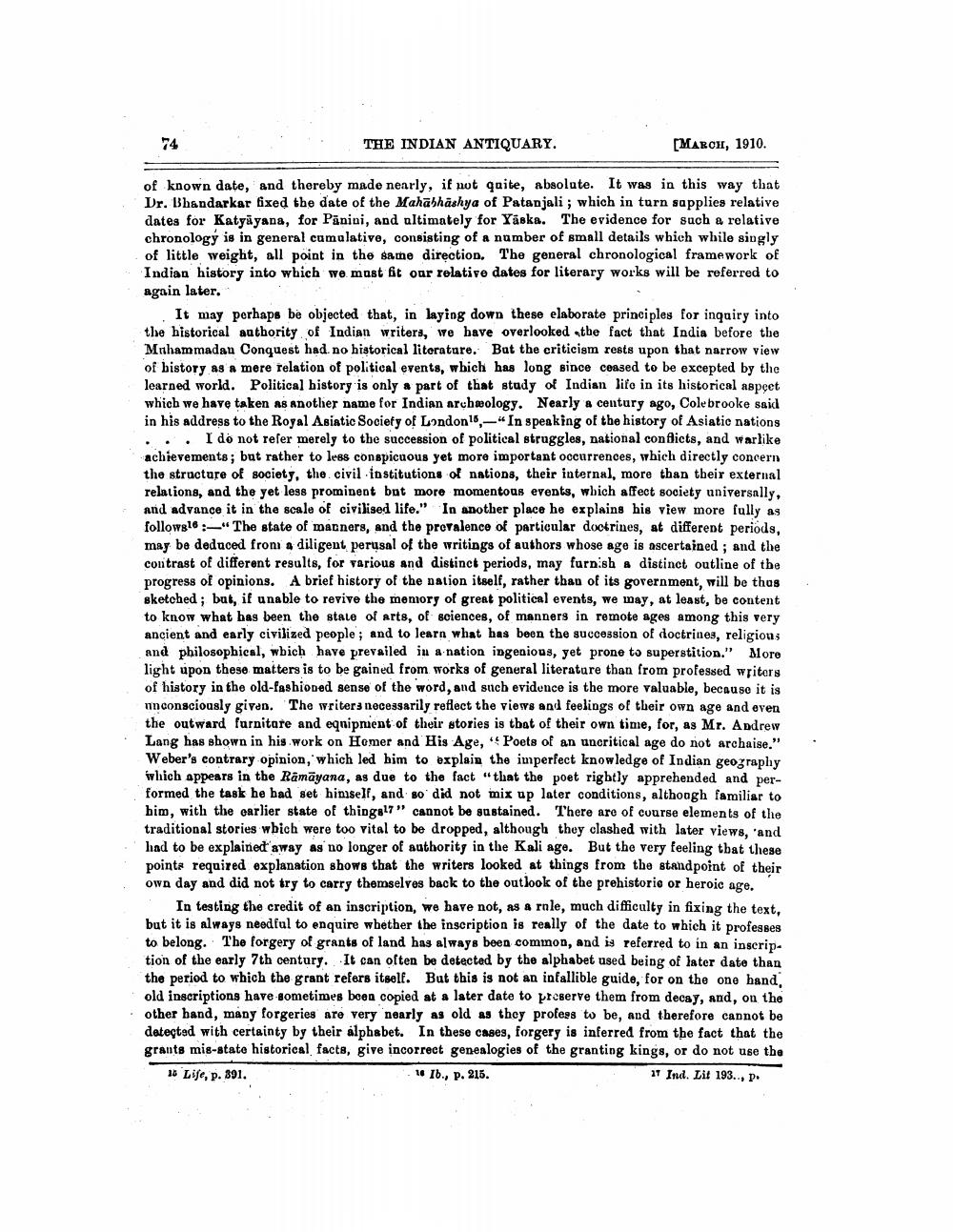________________
THE INDIAN ANTIQUARY.
[MARCH, 1910.
of known date, and thereby made nenrly, if not quite, absolute. It was in this way that Dr. Bhandarkar fixed the date of the Mahabhashya of Patanjali; which in turn sapplies relative dates for Katyāyana, for Pānini, and ultimately for Yaska. The evidence for such a relative chronology is in general cumulative, consisting of a number of small details which while singly
of little weighit, all point in the same direction. The general chronological framework of - Indian history into which we must fit our relative dates for literary works will be referred to again later.
It may perhaps be objected that, in laying down these elaborate principles for inquiry into the historical authority of Indian writers, we have overlooked the fact that India before the Mohammadan Conquest had.no historical literature. But the criticism rests upon that narrow view of history as a mere relation of political events, which has long since ceased to be excepted by the learned world. Political history is only a part of that study of Indian life in its historical aspeet which we have taken as another name for Indian archeology. Nearly a century ago, Colebrooke said in his address to the Royal Asiatic Society of London 15,-"In speaking of the history of Asiatic nations ... I do not refer merely to the succession of political struggles, national conflicts, and warlike achievements; but rather to less conspicuous yet more important occurrences, which directly concern the structure of society, the civil institutions of nations, their internal, more than their external relations, and the yet less prominent but more momentous events, which affect society universally, and advance it in the scale of civilised life." In another place he explains his view more fully as followg16 -" The state of manners, and the prevalence of particular doctrines, at different periods, may be deduced froni a diligent perusal of the writings of authors whose age is ascertained ; and the contrast of different results, for various and distinct periods, may furnish a distinct outline of the progress of opinions. A brief history of the nation itself, rather than of its government, will be thus sketched; but, if unable to revive the memory of great political events, we may, at least, be content to know what has been the state of arts, of sciences, of manners in remote ages among this very ancient and early civilized people ; and to learn what has been the succession of doctrines, religious and philosophical, wbich have prevailed in a nation ingenious, yet prone to superstition.” More light upon these matters is to be gained from works of general literature than from professed writers of history in the old-fashioned sense of the word, and such evidence is the more valuable, because it is unconsciously given. The writers necessarily reflect the views and feelings of their own age and even the outward furnitare and eqnipnient of their stories is that of their own time, for, as Mr. Andrew Lang has shown in his work on Homer and His Age, Poets of an uncritical age do not archaise." Weber's contrary opinion, which led him to explain the imperfect knowledge of Indian geography which appears in the Ramāyana, as due to the fact that the poet rightly apprehended and performed the task he had set himself, and so did not mix up later conditions, although familiar to bim, with the earlier state of thing827" cannot be sustained. There are of course elements of the traditional stories wbich were too vital to be dropped, although they clashed with later views, and had to be explained away as no longer of authority in the Kali age. But the very feeling that these points required explanation shows that the writers looked at things from the standpoint of their own day and did not try to carry themselves back to the outlook of the prehistorie or heroic age.
In testing the credit of an inscription, we have not, as a rnle, much difficulty in fixing the text, but it is always needful to enquire whether the inscription is really of the date to which it professes to belong. The forgery of grants of land has always been common, and is referred to in an inscription of the early 7th century. It can often be detected by the alphabet used being of later date than the period to which the grant refers itself. But this is not an infallible guide, for on the one hand, old inscriptions have sometimes boen copied at a later date to preserve them from decay, and, on the other hand, many forgeries are very nearly as old as they profess to be, and therefore cannot be detected with certainty by their alphabet. In these cases, forgery is inferred from the fact that the grants mis-state historical facts, give incorrect genealogies of the granting kings, or do not use the 15 Life, p. 391. 1. Ib., p. 215.
11 Ind. Lit 193.., D.




